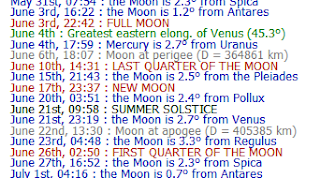June.
Already.
Pulled the data from COELIX APEX for June 2023.
We are in the pinched portion (on the northern side of this rocky ball) of the almanac chart. The hour glass shape...
Legend:
- Mercury - dark grey
- Venus - white
- Mars - orange
- Jupiter - yellow
- Saturn - green
- Uranus - aquamarine
- Neptune - dark blue
- middle of night - medium blue
Patterns:
- solid - meridian
- short dash - setting in evening
- long dash - rising in morning
Mars, Saturn, and Neptune are setting through the month. Saturn (16) and Neptune (28) are well-placed around midnight in the middle of the month, with no Moon around.
Jupiter is changing from a morning planet to late-night target. Uranus is also crawling out of the morning sky.
Very short nights for the astronomer. Visual observers need efficient plans; astrophotographers need to be ready to roll at astro-twilight.
Pulled the table.
Highlights include:
- Venus at greatest elongation. Way up. Waaaay up. Said Captain Kangaroo.
- "Summer solstice," for me, at The Elevator location. Over in Australia, it's the other solstice.
- New Moon phase on June 17. Hopefully we'll get some clear skies then. Without too much smoke...
And I generated the phenomena report.
02 12:01 Close encounter between Mars and M 44 (0.1° apart!)
03 23:42 FULL MOON
04 12:00 GREATEST EASTERN ELONGATION of Venus (45.3°)
04 17:59 Close encounter between Mercury and Uranus (2.7°)
06 06:08 Opposition of asteroid 11 Parthenope (mag 9.3)
08 00:37 Opposition of asteroid 39 Laetitia (mag 10.1)
10 15:31 LAST QUARTER OF THE MOON
11 03:58 Simultaneous transits on Jupiter: one satellite and shadows of two satellites
13 15:24 Close encounter between Venus and M 44 (0.5°)
16 07:13 Opposition of asteroid 20 Massalia (mag 10.0)
16 23:46 Close encounter between Mercury and Aldebaran (4.3°)
18 00:37 NEW MOON
21 10:58 SUMMER SOLSTICE
21 23:59 Close encounter between the Moon and Venus (2.7°)
26 03:50 FIRST QUARTER OF THE MOON
27 06:05 Meteor shower: June Bootids (duration = 11.0 days) *
01 00:48 Beginning of occultation of 20-sigma Sco (mag 2.90)
* See the wikipedia article for the June Bootids. I dunno if I'd get to riled up by this meteor shower, with an average rate of 1 to 2 per hour.




No comments:
Post a Comment